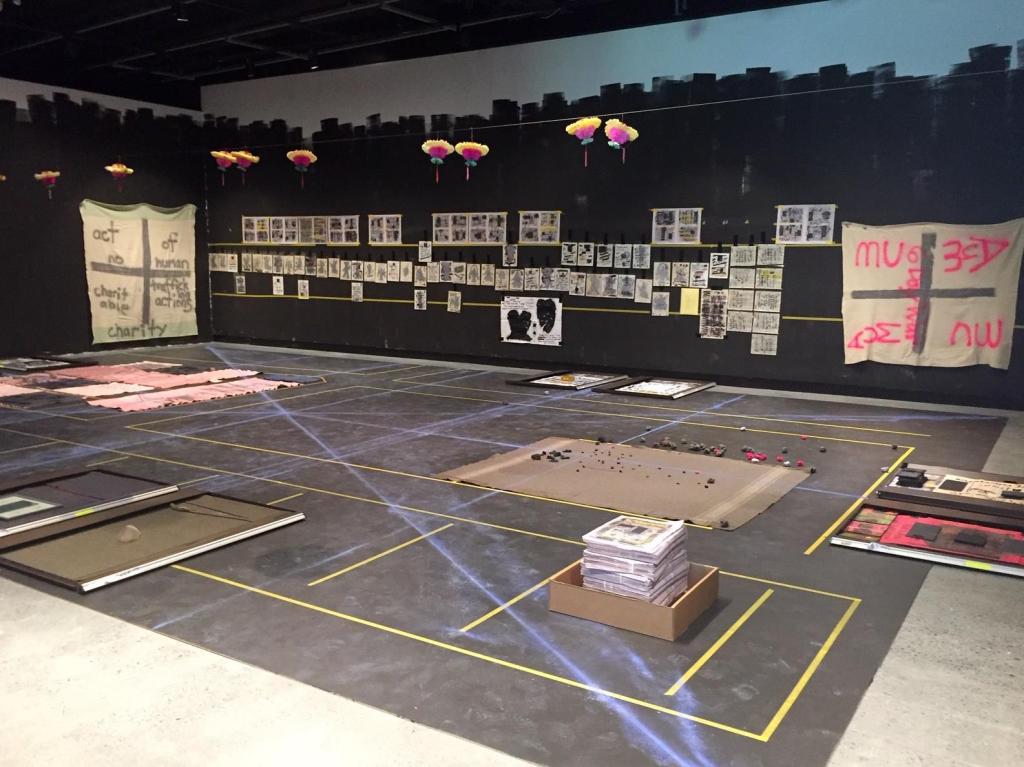Installation view Griffith University Art Museum, artist collective et al. mixed media installation No Good Common (2018); photo ArtsHub
Boundary Lines is a good example of an exhibition that can embrace the big topics, without having to be of big scale. It’s a smart exhibition that is beautifully curated, as ideas and connections weave across the works. And it’s generous and sparse at the same time.
Presenting just five artists: Vernon Ah Kee (AU), Daniel Boyd (AU), et al. (NZ), Carol McGregor (AU) and Rosângela Rennó (BR) – each with a single work, Boundary Lines explores how archival content – from spoken account, through documentation, ethnographic framing and redaction – is at once suspicious, heartfelt, and incomplete.
Curator of the exhibition, Griffith University Art Museum Director, Angela Goddard, describes: ‘Boundary Lines is an exhibition that exposes historical and contemporary fictions, and the way these myths continue to shape our understanding of history and future encounters.
‘Some works are laments. But, in the face of brutal tragedies and the background of colonial history, these works search for connection across the limits of experience and gaps in knowledge.’
That is most obviously played out in a new three-channel video by Vernon Ah Kee, The Island (2018), which presents the testimony of asylum seekers Zainab and Jawad, while – in contrast – these ideas are most subtly in captured in New Zealand artist Carol McGregor’s Cornerstone Project (2011-18), a tiny fragment of British Museum’s edifice as a gesture of resistance by the artist when denied access to material significant to her cultural heritage after months of repeated requests.

Installation view Carol McGregor’s Cornerstone Project (2011-18), cast silver, 4.9 x 4.6 x 4.3 cm; courtesy the artist, Photo ArtsHub
Lament … gaps … knowledge. I find it compelling how these two works can capture these concepts but at different scales, tones and subtleties.
McGregor’s work sits in beautiful conversation across the exhibition space with Daniel Boyd’s Decommissioned Skull Boxes; National History Museum, London (2017) – mimicking the cardboard boxes used by the museum to house human remains, collected in the name of science.
There is an ordinariness about these boxes with their labelling, basic scale, and simple storage function, and yet these objects – like McGregor’s – are so incredible charged for the cultural value they represent.

Daniel Boyd, Decommissioned skull boxes, Natural History Museum, London, 2017, 17 x 17 x 125cm. Collection of the artist. Courtesy the artist, Roslyn Oxley9 Gallery, Sydney, and Station Gallery, Melbourne; Installation detail Griffith University Art Gallery, Photo ArtsHub
In both, it is upon understanding their contents, that the viewer must face their own questions as witness to history.
Unlike McGregor, Boyd did get permission to access the National History Museum London’s archive during a 2011 residency, and First Nations artists Judy Watson, Christian Thompson and Brook Andrew were granted access to the British Museum’s holdings.
McGregor’s gesture of resistance, for this writer, is the “biggest” piece in this show. Measuring just under 5cm square, and cast in silver, she used a two-part dental putty to take a mould of one of the Museum’s iconic columns – using a gesture not unlike plastic explosives to massage and mould the putty into place.
Goddard explained it as an ‘attempt to take something back’, the use of silver symbolic of the value of the objects held within, and denied.
The role of the archive is further interrogated by the artist collective et al. through their mixed media installation No Good Common (2018), which dominated the main gallery.
A kind of flotilla of documentation, with no end in sight, it untethers archive material from its source and context, repurposing its meaning scattered across floors and walls as an aesthetic consideration. It feels compartmentalised, authoritative in its assigning of space and material, and yet there is not logic offered to decode what we see.
Goddard describes: ‘(it) recognises the potential of absurdity and paradoxical nonsense in the processes of cultural documentation and classification.’
It circles us back conceptually to the two video works in the exhibition, which effectively are presented as bookends across the space.
Rosângela Rennó single channel video, Vera Cruz (2000) addresses the moment of “first contact”, anchored by a letter to the King of Portugal which reports the first encounter with the landmass of Brazil and the Indigenous Tupi.
The images are scratchy; they feel washed out – metaphorically capturing a worn-out tale repeatedly told but increasing abraded and raw.

Detail / video still Vernon Ah Kee The Island (2018); commission by Griffith University Art Museum
Continuing the tiered narrative of contact is Ah Kee’s aforementioned video that pits very personal asylum testimony with footage of Palm Island, the country of his matrilineal heritage and a like-site plagued with a checkered colonial history.
Goddard describes as an exercise that invokes parallel narratives of brutalisation and dehumanisation between island prisons and Australia’s colonial history.
Ah Kee is not new to video, but this new work feels a little unresolved in the way it structures those shared messages. It is a big ask in under 10 minutes of screen time.
The piece was Commissioned by Griffith University for this exhibition.
Overall, this exhibition is conceptually tight and eloquent in its dialogue with viewers.
Rating: 4 stars ★★★★
Boundary Lines
Curated by Angela Goddard
The exhibition includes respected artists Vernon Ah Kee (AU), Daniel Boyd (AU), et al. (NZ), Carol McGregor (AU) and Rosângela Rennó (BR)
20 November 2018 – 23 February 2019
Griffith University Art Museum, Brisbane





